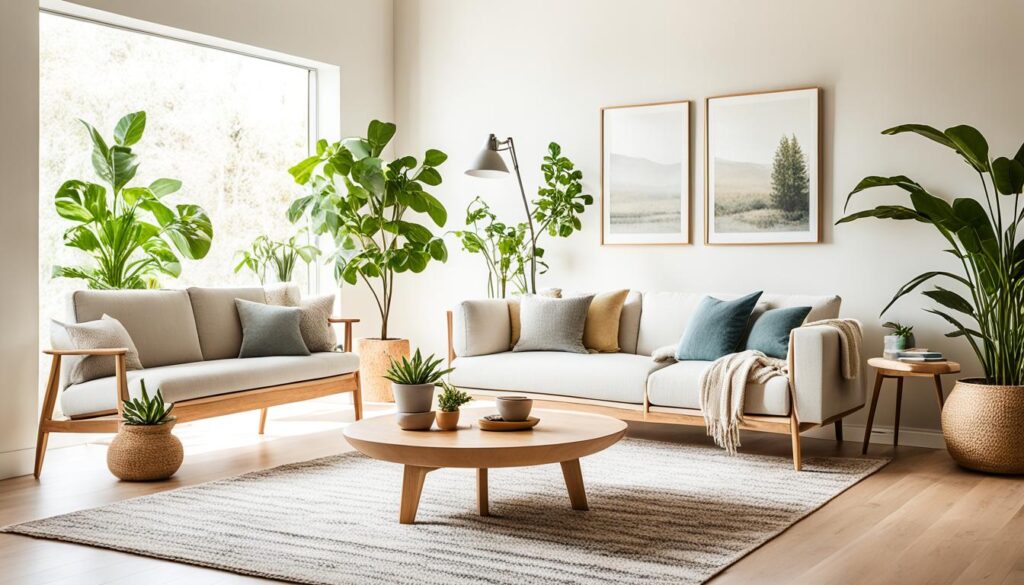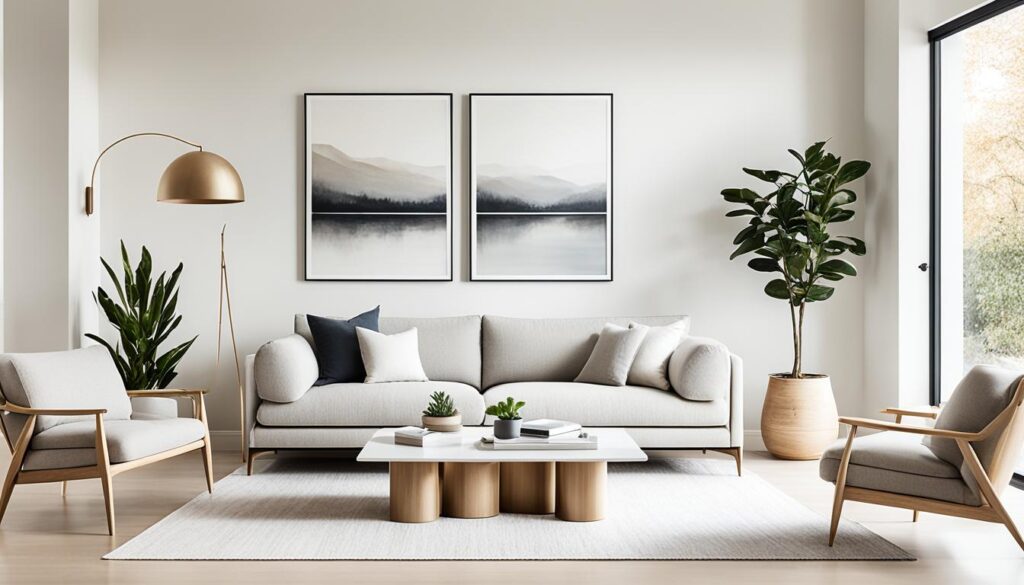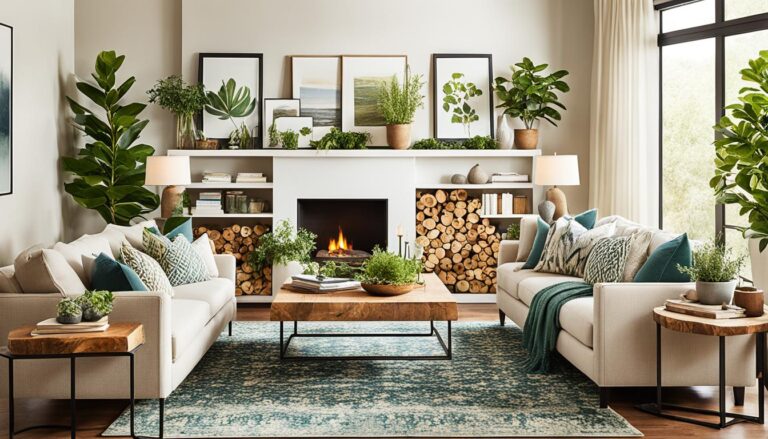Craving a living space that truly reflects your unique style? You’re in the right place! Let’s explore exciting interior design inspiration to transform your home. We’ll dive into fresh interior design trends and home decor ideas for various tastes.
Ready to revamp your space? This guide offers inspiration for single rooms or entire homes. You’ll find the latest trends and clever space-saving solutions.
Learn innovative ways to bring nature indoors. These ideas will help create a stylish and comfortable living environment.
Key Takeaways
- Explore a variety of interior design styles and trends to find inspiration for your home
- Learn how to incorporate bold colors, sustainable materials, and biophilic design elements
- Discover space-saving solutions and ways to mix and match styles for a unique look
- Gain insights into the importance of lighting and creating a cozy atmosphere
- Find inspiration for every room in your home, from the living room to the bathroom
Embrace the Power of Color in Your Home
Color can transform the mood of any living space. Choose color schemes that match your style and desired atmosphere. This will help you create a home that reflects your personality.
Let’s explore various color palettes. These can breathe new life into your interior design.
Bold and Vibrant Hues
Bold colors are perfect for those who love drama and energy. Deep shades like midnight blue, forest green, and fiery orange make powerful statements. They infuse your home with confidence and vitality.
Use these daring colors for focal points. They work well on accent walls or statement furniture pieces. These choices will draw the eye and spark conversation.
Soothing Pastel Palettes
Pastel colors create a tranquil and serene atmosphere. Soft hues like blush pink, powder blue, and mint green are calming. They instantly put you and your guests at ease.
These gentle color schemes work well in bedrooms and bathrooms. They’re also great for cozy reading nooks. Use them where relaxation and comfort are top priorities.
Monochromatic Elegance
For a sophisticated look, try a monochromatic color scheme. This uses varying shades and tones of a single color. It creates a harmonious and visually striking effect.
Monochromatic designs can range from soothing neutrals to bold choices. Examples include beige, gray, deep purple, or vibrant teal. Add depth by using different textures and patterns within the same color family.
| Color Scheme | Mood and Atmosphere | Ideal Spaces |
|---|---|---|
| Bold and Vibrant | Energetic, Dramatic, Confident | Living Rooms, Dining Rooms, Home Offices |
| Pastel Palettes | Calming, Serene, Inviting | Bedrooms, Bathrooms, Reading Nooks |
| Monochromatic | Sophisticated, Cohesive, Harmonious | Living Rooms, Bedrooms, Kitchens |
Choose colors that match your style and create the desired mood. Don’t be afraid to try different color combinations. Trust your instincts when creating a space that feels like you.
Maximizing Small Spaces with Smart Design
Small spaces can be stylish and functional. With smart design strategies, you can create a cozy and inviting living area. Here are some tips to make the most of your limited square footage.
- Choose multifunctional furniture, such as a sofa bed or a storage ottoman, to serve multiple purposes and help you maximize your space.
- Utilize vertical storage solutions, like wall-mounted shelves or hanging organizers, to free up valuable floor space while keeping your belongings organized.
- Opt for furniture with slim profiles or transparent materials to maintain an open and airy feel in your small space.
- Incorporate mirrors strategically to reflect light and expand the sense of space in your room.
- Use light colors on walls, floors, and furniture to create the illusion of a larger room and a brighter atmosphere.
Smart layout, storage, and décor choices are crucial for small spaces. Space-saving solutions and multifunctional furniture can make compact areas feel roomy. Be strategic with every design decision to maximize your living space.
The key to living large in a small space is to be intentional with every design decision, from the furniture you choose to the colors you use on your walls.
Here are a few more ideas to help you get the most out of your small space:
| Space-Saving Solution | Benefit |
|---|---|
| Murphy bed | Folds up into the wall when not in use, freeing up floor space |
| Nesting tables | Can be stacked when not in use, saving space |
| Wall-mounted desk | Takes up less floor space than a traditional desk |
| Over-the-door organizer | Utilizes often-overlooked storage space behind doors |
Living in a small space lets you get creative. Embrace smart storage solutions and multifunctional furniture. You can design a stylish and spacious-feeling home, regardless of its size.
Bring Nature Indoors with Biophilic Design
Biophilic design connects living spaces with nature. It promotes well-being, reduces stress, and creates a calming atmosphere. Let’s explore ways to bring the outdoors inside.
Incorporating Plants and Greenery
Adding plants is a simple way to introduce biophilic design. Indoor plants enhance aesthetics and offer health benefits. They purify air, remove toxins, and increase oxygen levels.
Consider these options for incorporating plants:
- Potted plants: Place a variety of potted plants throughout your home, such as snake plants, peace lilies, or fiddle leaf figs.
- Hanging plants: Utilize vertical space by suspending plants from the ceiling or placing them on high shelves.
- Living walls: Create a stunning focal point by installing a living wall, which consists of a vertical garden filled with a diverse array of plants.
- Terrariums: Design miniature ecosystems within glass containers, showcasing small plants, rocks, and decorative elements.
Natural Materials and Textures
Natural materials and textures are key to biophilic design. They create a connection with outdoors and add warmth and character. Consider these popular natural materials:
| Material | Application | Benefits |
|---|---|---|
| Wood | Flooring, furniture, accents | Adds warmth, texture, and a natural feel |
| Stone | Countertops, accent walls, flooring | Provides a sense of solidity and durability |
| Organic fabrics | Curtains, upholstery, bedding | Offers comfort, softness, and a natural aesthetic |
| Bamboo | Flooring, furniture, decor | Eco-friendly, durable, and stylish |
By embracing biophilic design and incorporating natural elements into your home, you can create a space that promotes well-being, reduces stress, and connects you with the beauty of the natural world.
Biophilic design enhances visual appeal and supports eco-friendly living. Natural materials and plants reduce environmental impact. They create a healthier living space for you and your family.
Mixing and Matching Styles for a Unique Look
Breaking design rules can lead to captivating living spaces. Combining elements from different eras and cultures creates an eclectic interior. This approach reflects your unique taste and personality.
Eclectic Fusion
Eclectic fusion embraces diversity and blends seemingly disparate elements. Start with a neutral base and layer in pieces from various styles. Find a common thread to tie everything together, like a cohesive color palette.
Pair a sleek, modern sofa with a vintage Persian rug and industrial coffee table. Choose pieces with similar colors or textures to create continuity and balance.
“The best rooms have something to say about the people who live in them.” – David Hicks
Blending Modern and Vintage Elements
Mixing modern and vintage elements adds depth and character to your space. The contrast of clean lines and antique charm creates a unique atmosphere. This fusion brings history into your living area.
To successfully blend styles, balance modern and vintage proportions. Use modern pieces as backdrops for vintage finds. Add character with vintage accessories like mirrors, lamps, or artwork.
- Balance the proportion of modern and vintage elements to avoid overwhelming the space
- Use modern pieces as a backdrop for showcasing vintage finds
- Incorporate vintage accessories, such as mirrors, lamps, or artwork, to add character to a modern room
- Refurbish vintage furniture with contemporary fabrics or finishes to create a fresh, updated look
| Modern Elements | Vintage Elements |
|---|---|
| Clean lines | Ornate details |
| Neutral colors | Rich, saturated hues |
| Sleek materials (glass, metal) | Weathered finishes (wood, leather) |
| Minimalist shapes | Curved, organic forms |
Mixing styles creates a home that’s truly one-of-a-kind. It reflects your personal journey and experiences. Embrace experimenting with design and let your space tell your unique story.
Lighting as a Key Element in Interior Design
Lighting design can transform any space. It creates a warm atmosphere, highlights key features, and provides functionality. Consider three main types: ambient, task, and accent lighting.
Ambient lighting sets the general mood of a room. It provides overall illumination through ceiling fixtures, wall sconces, or natural light. The goal is to create balanced light distribution throughout the space.
Lighting is the jewelry of the home, and like the perfect necklace, it can completely transform the look of a room.
Task lighting offers focused illumination for specific activities. It should be bright enough to prevent eye strain. Examples include desk lamps and under-cabinet lighting in kitchens.
Accent lighting highlights specific features or objects in a room. It adds depth and interest to your interior design. Options include track lighting, picture lights, and recessed spotlights.
| Lighting Type | Purpose | Examples |
|---|---|---|
| Ambient Lighting | Overall illumination and setting the mood | Ceiling fixtures, wall sconces, natural light |
| Task Lighting | Focused illumination for specific activities | Desk lamps, under-cabinet lighting, pendant lights |
| Accent Lighting | Highlighting specific features or objects | Track lighting, picture lights, recessed spotlights |
When planning your lighting design, consider these tips:
- Layer different types of lighting to create a flexible and adaptable space
- Use dimmers to adjust the brightness and mood of your lighting
- Consider the function of each room and choose appropriate lighting fixtures
- Ensure that your lighting complements your overall interior design style
Good lighting design creates a beautiful, functional living space. It reflects your personal style and meets your daily needs. Implement these principles to transform your home.
Sustainable and Eco-Friendly Interior Design Ideas
Eco-friendly interior design is gaining popularity among homeowners. People want stylish, comfortable spaces that are also kind to the environment. By using sustainable materials and energy-efficient solutions, we can create beautiful, planet-friendly homes.

Recycled and Repurposed Materials
Using recycled and repurposed materials is a great way to design eco-friendly spaces. Reclaimed wood adds unique character and warmth to any room. Vintage furniture reduces waste and gives new life to pre-loved pieces.
Upcycling turns everyday objects into stylish decor items. For example, old glass bottles become unique vases. Salvaged doors can be transformed into statement headboards.
When choosing materials for eco-friendly design, look for specific qualities. Seek products made from recycled content or sustainably harvested materials. Choose locally sourced items to reduce transportation emissions.
- Made from recycled content
- Sustainably harvested or produced
- Locally sourced to reduce transportation emissions
- Durable and long-lasting to minimize waste
Energy-Efficient Lighting and Appliances
Energy efficiency is crucial in sustainable interior design. It reduces our carbon footprint and lowers utility bills. LED light bulbs use 90% less energy than incandescent bulbs and last longer.
When choosing appliances, look for the Energy Star label. This indicates they meet strict efficiency guidelines set by the U.S. Environmental Protection Agency.
| Appliance | Energy Star Certified | Estimated Annual Savings |
|---|---|---|
| Refrigerator | Yes | $50 |
| Dishwasher | Yes | $25 |
| Washing Machine | Yes | $45 |
| Air Conditioner | Yes | $75 |
Smart home technologies can further optimize your energy usage. Programmable thermostats and occupancy sensors adjust your home’s temperature and power consumption automatically. These devices save money and reduce your environmental impact based on your daily routines.
The key to successful eco-friendly interior design is to make thoughtful choices that prioritize sustainability without compromising style or comfort. By embracing recycled materials, energy-efficient solutions, and smart technologies, we can create beautiful, healthy, and environmentally responsible living spaces that we can feel good about.
Creating a Cozy and Inviting Atmosphere
Interior design plays a crucial role in crafting a cozy atmosphere. A warm and welcoming space enhances your enjoyment of home. Let’s explore key elements that contribute to a cozy interior design.
Plush Textiles and Soft Furnishings
Plush textiles and soft furnishings are essential for a cozy atmosphere. Chunky knit blankets, fluffy pillows, and soft rugs add visual interest and texture. These elements invite relaxation and comfort.
Choose natural materials like cotton, wool, and linen for breathability and comfort. Layer different textures for depth and dimension. Try a knit throw over a velvet sofa or a shaggy rug on hardwood.
Warm and Welcoming Color Schemes
Choosing a warm color scheme is vital for cozy interior design. Rich, earthy tones like deep reds and golden yellows make spaces inviting. Soft, muted colors create a sense of calm and tranquility.
Consider the mood you want in each room when selecting colors. A warm palette suits a cozy living room. Soft, muted hues work well in bedrooms for relaxation.
Lighting is crucial for creating a cozy atmosphere. Soft, warm light from lamps and dimmers enhances ambiance. Mix lighting sources for a layered, cozy look.
Combine plush textiles, warm colors, and soft lighting for a cozy home. This creates a welcoming space for relaxation and entertaining. Your home becomes a true haven for life’s precious moments.
The Timeless Elegance of Minimalism
Minimalist interior design is gaining popularity for its simplicity and functionality. It creates a serene and sophisticated living space. By decluttering, you can achieve tranquility and order in your home.

Minimalism focuses on keeping only essential and meaningful items. This decluttering process frees up space and promotes mental clarity. With fewer distractions, you can appreciate each carefully chosen object’s beauty and purpose.
Simplicity is the ultimate sophistication.
To achieve a minimalist look, consider these tips:
- Opt for a neutral color palette, featuring shades of white, gray, and beige
- Choose furniture with clean lines and simple geometric shapes
- Invest in high-quality, timeless pieces that will stand the test of time
- Maximize natural light to create a bright and airy atmosphere
- Incorporate texture through materials such as wood, stone, and natural fibers
Focus on a few well-chosen pieces and let them shine. This approach creates a minimalist interior that exudes simple elegance. It promotes a sense of calm and well-being in your living space.
Interior Design Inspiration for Every Room
Every room in your home needs special attention for great design. Each space has a unique purpose and needs a tailored approach. Let’s explore design ideas for key rooms in your house.
Living Room Inspiration
The living room is your home’s heart. It’s where you relax, entertain, and gather with family. Create a cozy atmosphere that shows your style.
Add comfy sofas and smart storage like built-in shelves. Use neutral colors with bright accents to tie the room together. Add personal touches with family photos and artwork.
Bedroom Inspiration
Your bedroom should be a peaceful place for rest. Focus on creating a soothing and inviting space. Use soft textures like plush bedding and cozy throws.
Choose calm colors like pastels or earth tones. Add smart storage to keep your room tidy. Include personal items like artwork or family heirlooms.
Kitchen Inspiration
The kitchen needs to blend function and style. Add modern appliances to make cooking easier. Use tough, easy-clean materials like quartz counters.
Design a good layout with plenty of work space. Add personal flair with colorful tiles or unique cabinet handles. Make your kitchen both useful and beautiful.
Bathroom Inspiration
Turn your bathroom into a spa-like retreat. Add luxury touches like marble counters or a freestanding tub. Use calming colors such as soft blues or warm grays.
Include smart storage to keep things organized. Add personal touches like a plush bath mat or pretty artwork. Create a true oasis for relaxation.
| Room | Key Elements | Color Scheme | Personal Touches |
|---|---|---|---|
| Living Room | Comfortable seating, functional storage | Neutral tones with vibrant accents | Family photos, artwork, decorative objects |
| Bedroom | Soft textures, smart storage | Calming pastels or earthy tones | Favorite artwork, cherished heirlooms |
| Kitchen | Modern appliances, durable materials | Bright and inviting | Colorful backsplash, unique cabinet hardware |
| Bathroom | Luxurious finishes, smart storage | Soft blues or warm grays | Plush bath mat, beautiful artwork |
Conclusion
Interior design offers endless ways to transform your living space. From bold colors to sustainable materials, you can create a personalized haven. Your home should reflect your unique style and lifestyle.
Design is a personal journey. Create a space that makes you happy and comfortable. Don’t hesitate to mix styles and incorporate elements you love.
Trust your instincts and embrace creativity. This approach will help you craft a home that feels truly yours.
Let this guide inspire your design adventure. Start small or renovate completely – the choice is yours. Explore different ideas and plan your ideal living space.
Take time to gather inspiration. Enjoy turning your home into a sanctuary that reflects your taste and style.



